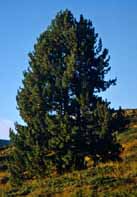
Group of trees (3 stems) that grew from a nutcracker (Nucifraga sp.) cache, in habitat, Rilski Ezera, Rila Mts., Bulgaria, at treeline at 2200m [Michael Frankis] (3).
Common Names
Macedonian pine (1), bela mura, molika [Serbian], sosna Balkanskaya [Russian], Mazedonische kiefer [German], pin des Balcans [French], pino dei Balcani [Italian] (6), bela mura [Bulgarian].Taxonomic notes
Closely allied to the Himalayan P. wallichiana, but having shorter, stiffer leaves and shorter cones.Claims that "Macedonian pine from Bulgaria is a separate variety vermiculata Christ, which differs from the western [Yugoslav] P. peuce with thinner and shorter needles, [and] shorter cones" (Cernjavski et al. 1959, cited in (1)) are not supported by observations. Bulgarian material shows the full range of measurements published for the western populations (4); variation of this sort was found to occur with increased altitude within Bulgaria, but not with geographical origin (4).
Description
Tree to 35-40 m tall, and 50-150 cm dbh. Bark on young trees smooth silvery grey, becoming darker and rough in middle age; very old trees with thick brown square-fissured bark. Branches level in lower crown, becoming erect in upper crown and at ends of branches; high altitude trees tend to have more erect branches than at lower altitudes. Shoots uninodal, green at first, grey-brown by end of first year, smooth, glabrous. Leaves 5 per fascicle, 4.5-10 cm long (not over 7 cm on treeline trees), slender, 0.7-0.8 mm thick, glossy green on outer face with white stomatal lines on inner faces, margins minutely serrulate; persistent 2-5 years; sheath 10-15 mm, deciduous by end of first autumn. Cones pendulous, (5-) 9-18 (-20) cm long (stunted, 5-13 cm, at treeline), cylindric, straight to slightly curved, green ripening orange-brown, scales adpressed to slightly incurved when cone closed (never reflexed at the cone base as in e.g. P. monticola); scales large, thin and fragile, apophysis smoothly rounded, 20 mm; umbo terminal, 2-3 mm, dark grey, unarmed. Cone peduncle 1 cm, grey, 6-8 mm thick. Seeds grey-brown, 7-8 mm with an adnate 14-22 mm wing; shed as soon as cones mature in October, 17-18 months after pollination. (4, additional data from 1).Range
Balkan peninsula - Yugoslavia, Macedonia, W Bulgaria, N Greece, Albania, at 600-2200 m altitude (1, 4, 6). Usually found on N slopes of on siliceous soils, rarely on carbonate soils (6). Naturalised at Punkaharju, Finland (R.M. Lanner, paper in (5)).Big Tree
Trees to 35 m, possibly 40 m, are frequent in the Rila and Pirin Mts, Bulgaria; a few very old trees with stem diameters over 1.5m (4). There is a report of a very large tree near the Rila Monastery, Bulgaria (2).Oldest
Dendrochronology
Ethnobotany
Wood light, soft and durable. Used in building. Resin used in optical instruments industry (6) (although not as widely used as resin from species of Abies). A valuable ornamental tree, very popular in Scandinavian parks and gardens, where it is known as 'Silkefyr' ['Silk pine'] from its silky foliage."At the Conifer Conference in 1972 it was described as 'undoubtedly the most useful five-needled pine for landscape planting" (7). USDA hardiness zone 5.Observations
Remarks
At high altitudes (over 1800 m) multitrunk trees are frequent, to predominant at the 2200 m treeline, indicating seed dispersal by nutcrackers (Nucifraga caryocatactes), with trees germinating several together from unutilised seed caches (4). The Finnish naturalised trees were also dispersed by nutcrackers (R.M. Lanner in (5)).Very resistant to white pine blister rust, Cronartium ribicola.
This species is listed as "LR/nt" (lower risk, near threatened) by the World Conservation Monitoring Centre - Trees database. Most or all in Bulgaria are now protected in National Parks. The only 'felled' trees seen on a visit in September 1998 were a few avalanche victims (4).
Citations
(1) Popnikola, N., M. Jovancevic & M. Vidakovic 1978. Genetics of Pinus peuce Gris. Annales Forestales 7/6: 187-206.(2) Vladimir Dinets, e-mail communication, 10-Jan-1998.
(3) Photograph received in e-mail as a BMP file, 19-Dec-1998.
(4) M.P. Frankis, field notes and collections, Pirin & Rila Mts, Bulgaria, September 1998.
(5) Richardson 1998.
(6) Branislav JovanoviŠ. 1986."Pinus peuce," in Flora Srbije. Belgrade: Serbian Academy of Sciences and Arts.
(7) Hugh Johnson. 1993. The International Book of Trees. London: Mitchell Beazley.
Thanks to Milan Jovanovic for information and assistance contributed Feb-1999.
[Pinus] [Pinaceae] [home]
This page is from the Gymnosperm Database
URL: http://www.geocities.com/~earlecj/pi/pin/peuce.htm
Edited by Christopher J. Earle
E-mail:earlecj@earthlink.com
Last modified on 25-Mar-1999